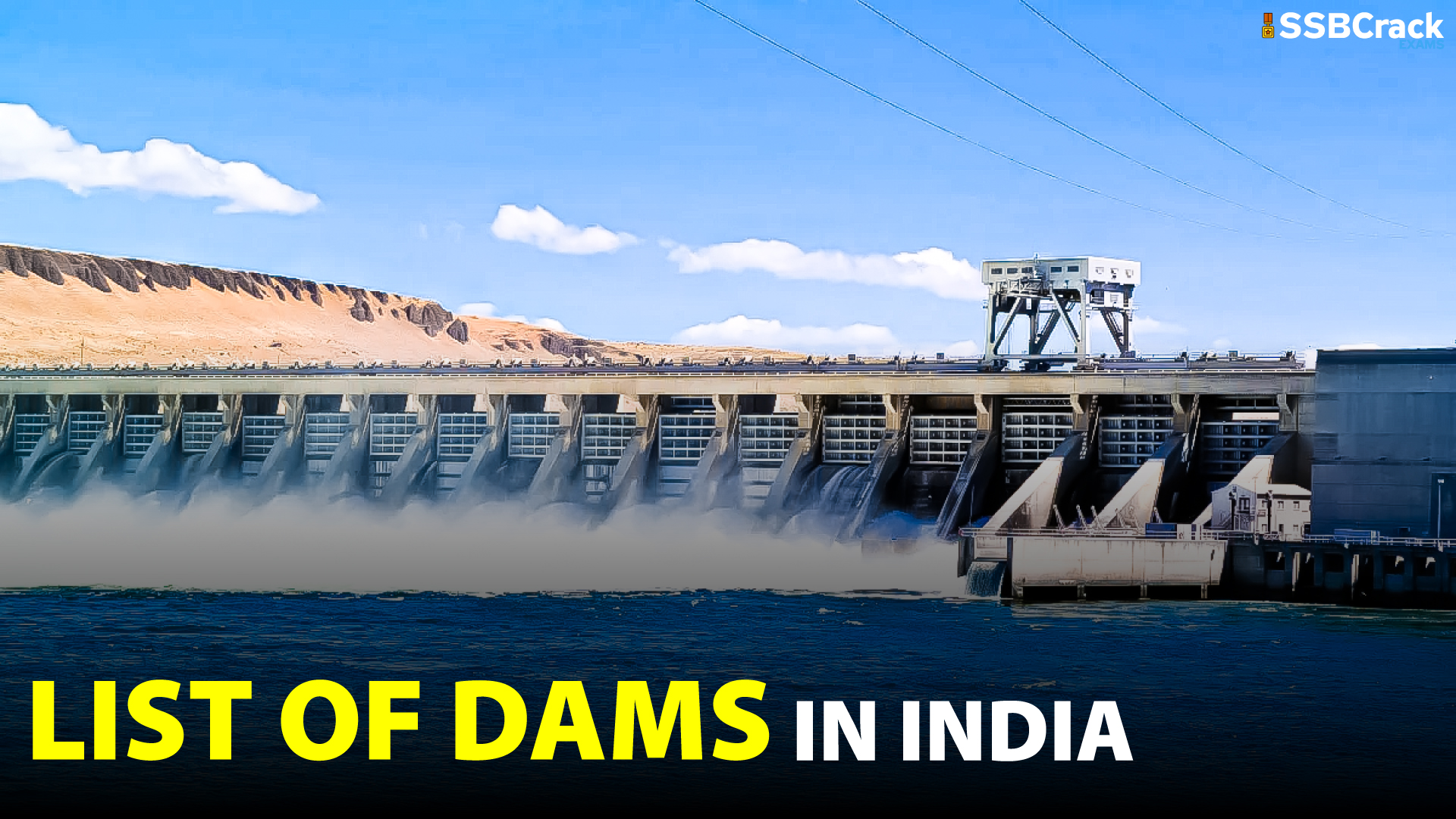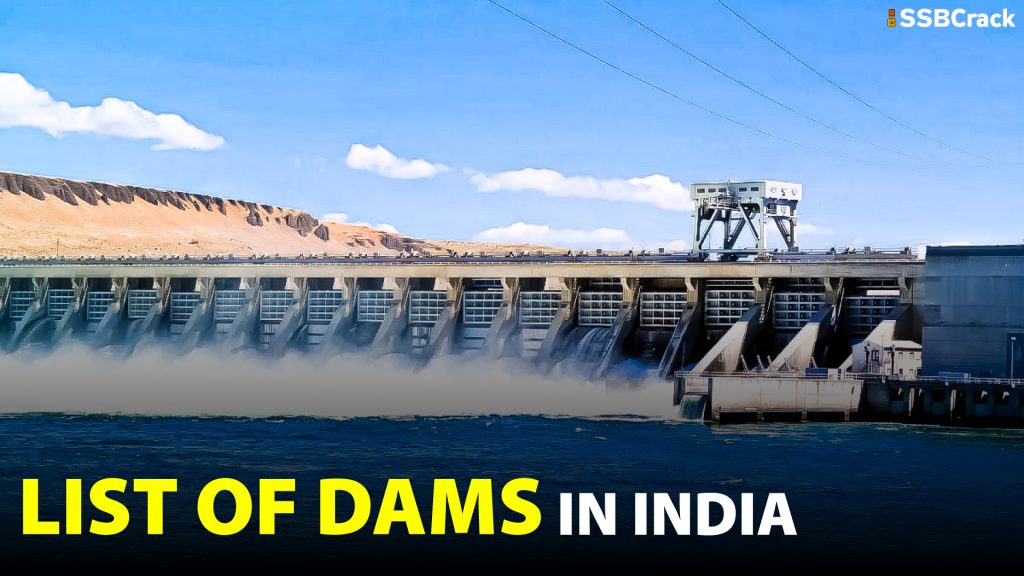List of Dams in India
Questions regarding dams were always asked in Competitive exams as dams, water management makes up the general awareness part of the syllabus. So, reading about Dam is a must for all the government exam aspirants out there.
What is a Dam?
A dam is a build-up, a barrier that stops or limits the flow of the surface water or underground streams. Reservoirs that are created out of the dam not only control flood but also provide potential space for many activities such as irrigation, human consumption, aquaculture, industrial use, and navigability.
Dams serve the basic function of storing and distributing water as per the need. India currently has 5202 large dams which serve different purposes such as limiting the flow of water, irrigation and other facilities.
Tamil Nadu has the most no. Of dams in India, which are followed after by Karnataka. Tamil Nadu also holds the title of having the oldest Dam in India, which is the Kallanai Dam in the Thanjavur district.
The earliest known dam is the Jawa Dam in Jordan, dating to 3,000 BC.
Significance of Dams
One of the major benefits of the Dam is Hydroelectricity. Hydropower is used with the flowing water to create hydroelectricity. And that electricity is used to illuminate even the most backward villages and areas in India. So, the presence of Dam is itself a good asset for any region. Other benefits of dams are given below :-
- Source of Clean Energy
Dams provide hydroelectricity, which is a clean fuel. It helps in lessening the reliance upon fossil fuels, which are depleting very fast.
Also, fossil fuels are a source of carbon and many other gases which are considered to be harmful to human existence. This contributes to air pollution.
Hydroelectricity being clean energy holds an important place in energy consumption and hence, Dams become significant for all.
- Irrigation
Irrigation is influential for agriculture. It is the most powerful aspect of good production in Agriculture. The existence of Dam in any area helps the area in booming their agriculture through the irrigation facilities provided by the dam.
Punjab and Haryana and many such states get the needed amount of water from the dams to irrigate their field.
Hence, dams are important for the development of Indian Agriculture as well.
- Prevention of Flood
Flood causes misery to the state. It leads to death, injuries, the destruction of many areas and the natural habitat of people. India being geographical, a country with many flowing rivers, faces floods more often than any other country. This problem is solved to an extent by Dam. They control the flow of water and prevent flood situations in any area.
- Availability of Drinking water
Safe drinking water is necessary for a better living apart from food and shelter. Geographically, India is a very diverse country. Some areas have adequate freshwater, whereas some areas stay dry most of the year. The dams play an important role in striking the balance between them. It provides drinking water to every area, irrespective of the geographical location. The water from the Dams is distributed to other areas to provide drinking water.
Types of Dam
Before moving further to the list of dams present in India, it is significant to know the types of Dam. This topic is Vital to read as a lot of questions on the types of Dams are asked in the competitive exams. Here we will learn about types of Dams.
- Arch Dam
A concrete arch dam has a layout that curves upstream. It’s made so that the hydrostatic pressure (water’s force against it) pushes against the arch, straightening it slightly and strengthening the structure as it pushes into the foundation or abutments. An arch dam is best suited to small canyons or gorges with steep, sturdy rock walls to support the structure and stress.
- Gravity Dam
Gravity dams are dams made of concrete or stone masonry. They’re made to keep water out by relying on the material’s weight and resistance to the foundation to counteract the horizontal pressure of water pushing against it. These are constructed in such a way that each part of the dam is stable and self-contained.
- Arch-Gravity Dam
This dam combines the features of an arch dam and a gravity dam. It’s a dam that narrows as it goes upstream, directing the majority of the water pressure against the canyon rock walls. The lateral (horizontal) force exerted on the dam is reduced by the water’s inward compression.
- Barrages
A barrage is a low-head diversion dam with a series of big gates that may be opened and closed to control the volume of water that passes through. This enables the building to control and stabilize river water elevations upstream for irrigation and other purposes.
- Embankment Dams
An embankment dam is a massive man-made structure. A complicated semi-plastic mound of varied compositions of soil, sand, clay, or rock is often placed and compacted to make embankment dams. It has a solid, impenetrable core and a semi-precious waterproof natural coating for its surface.
- Rock-Fills Dams
Rock-fill dams are free-draining granular earth embankments with an impervious zone. The term “rock-fill” refers to an earth that has a high percentage of big particles.
- Concrete-face rock-fill dams
A concrete-face rock-fill Dam (CFRD) has concrete slabs on the upstream face of the dam. The concrete slab serves as an impervious wall to prevent leakage, as well as a structure that is unaffected by uplift pressure.
- Earth-fill dams
An earth-fill dam is a simple embankment of well-compacted earth but may contain a drain layer to collect seepage. A homogeneous rolled-earth dam is entirely constructed of one type of material and may contain multiple layers of this material.
The list of highest, longest and, the largest dam in India
Now, we will see the list of the highest, longest and largest dams in India which are very important from an exam perspective. These dams are significant from the general awareness perspective of the exam.
| Highest, longest and, the largest dam in India | ||||
| Highest Dam in India | Tehri Dam | Uttarakhand | River: Bhagirathi River | Height: 260.5 metersLength: 575 metersLocation: UttarakhandYear of completion:2006 (1st phase) |
| Longest Dam in India | Hirakud Dam | Odisha | River: Mahanadi | Total Length: 25.79 km (16.03 mi)Length of Main Dam:4.8 km (3.0 mi)Location: OdishaYear of completion:1953 |
| Oldest Dam in India | Kallanai Dam | Tamil Nadu | River: Kaveri | Location: Tamil NaduYear of completion: 100 BC –100 AD |
List of Major Dams in India
As we told earlier that Dams are an important static GK topic. So, we have provided the list of major dams below. These dams are significant because of their location and their economic use.
| Major Dams in India | State | River |
| Bhavani Sagar dam | Tamil Nadu | Bhavani |
| Tungabhadra Dam | Karnataka | Tungabhadra |
| Rihand Dam | Uttar Pradesh | Rihand |
| Maithon Dam | Jharkhand | Barakar |
| Koyna Dam | Maharashtra | Koyna |
| Bisalpur Dam | Rajasthan | Banas |
| Mettur Dam | Tamil Nadu | Kaveri |
| Krishnarajasagar Dam | Karnataka | Kaveri |
| Indira Sagar Dam | Madhya Pradesh | Narmada |
| Cheruthoni Dam | Kerala | Cheruthoni |
| Sardar Sarovar Dam | Gujarat | Narmada |
| Nagarjuna Sagar Dam | Telangana | Krishna |
| Hirakud dam | Odisha | Mahanadi |
| Bhakra Nangal Dam | Punjab-Himachal Pradesh Border | Sutlej |
| Damodar valley multipurpose project four dams: Tilaiya and Maithon (on the Barakar River), Konar (Konar River), and Panchet (Damodar River). | West Bengal (also shared by Jharkhand). | Damodar |
| Banasagar project | M.P., Bihar, and U.P. | Son |
| Thein Dam project | Punjab | Ravi |
| Beas Project (Sharda Sahayak Project) | A joint venture of Punjab, Haryana, and Rajasthan, Uttar Pradesh | Beas |
| Mayurakshi project | West Bengal | Mayurakshi |
| Poochampad Project | Andhra Pradesh | Godavari |
| Ghatprabha project | Andhra Pradesh and Karnataka. | Ghatprabha (A tributary of Krishna) |
| Bima project | Maharashtra | Bhima |
| Malprabha project | Karnataka | Malprabha |
| Shivasamudram Scheme | Karnataka | On Cauvery Falls |
| Kundah project | Tamil Nadu | Kundah |
| Sharavati Project | Karnataka | Sharavati (near Jog falls) |
| Chambal project(Gandhi Sagar Dam (M.P.), Rana Pratap Sagar and Jawahar Sagar Dam or Kota Dam. | Rajasthan, Madhya Pradesh | Chambal |
| Tawa project | Madhya Pradesh | Tawa (A tributary of Narmada. |
| Matatila Project | Uttar Pradesh, Madhya Pradesh | Betwa |
| Ukai Project | Gujarat | Tapi |
| Mahi Project (Jamnalal Bajaj Sagar) | Gujarat | Mahi |
| Jayakwadi Project | Maharashtra | Godavari |
| Malprabha project | Karnataka | Malprabha |
| Nanak Sagar Dam | Uttarakhand | Deoha river |
| Cheruthony Dam | Kerala | Periyar River |
| Peppara Dam | Kerala | Karamana River |
| Kakki dams | Kerala | Kaki River (a tributary of the Pampa) |
| Anathode dams | Kerala | Anathode river (a tributary of Pamba River) |
| Pampa Dam | Kerala | Pampa river |
Conclusion
Dams are an essential part of India’s economy. The dams provide irrigation facilities, aquaculture, navigation and other economical boons which helps in elevating the economic status of people engaged in those activities. The dams are also important as they prevent floods, help in managing the flow of water. India almost has 5202 large dams spread across various states in India. The highest dam in India is Tehri Dam, the longest dam is Hirakud dam, whereas the oldest dam is the Kallanai dam.
The readers can subscribe to SSBCrackExams to get more informative articles in their feed. All the best.
Also Read:
- List Of Tiger Reserves In India
- The Major Indian River Systems
- List Of National Parks In India




















